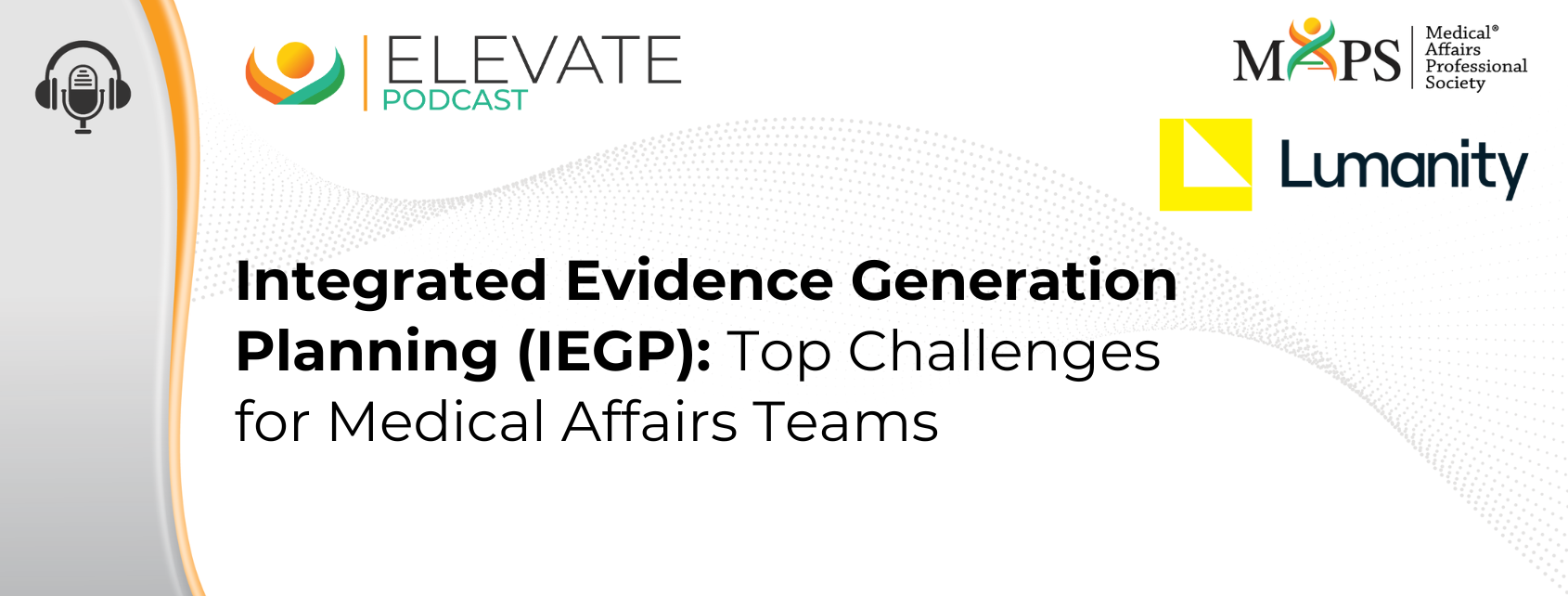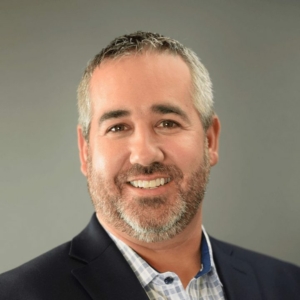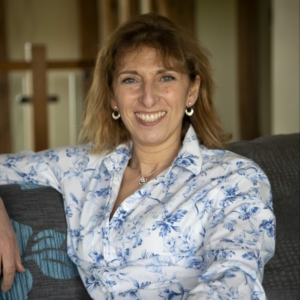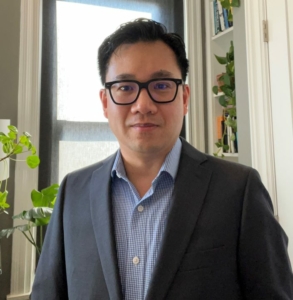Integrated Evidence Generation Planning: Top Challenges for Medical Affairs Teams
Speaker: John Howley, PharmD
Speaker: Ann-Marie Chapman
Speaker: Meena Venkatachalam
Speaker: Wilson Joe, PhD
Integrated evidence generation plans (IEGPs) are essential for alignment of key strategic priorities across functions, between regions and globally, through the product lifecycle. While Medical Affairs typically drives the process, input from multiple functions and stakeholders is essential to creating a successful IEGP. In this episode, Lumanity experts representing some of these functional stakeholder groups will take a closer look at the most common challenges that teams face when conducting Integrated Evidence Generation Planning within their organizations, including lack of cross-functional and regional alignment, resourcing and timing. This will be the first installment in a series of podcast episodes designed to take a deeper dive into each of the specific challenges associated with integrated evidence generation planning.
Following is an automated transcription provided by otter.ai. Please excuse inaccuracies.
Garth Sundem 00:00
Welcome to this episode of the Medical Affairs Professional Society podcast series, Elevate. I’m your host. Garth Sundem, Communications Director at MAPS, and today we’re talking about integrated evidence generation planning with experts from Lumanity. Joining us are John Howley, President, US Communications, Ann-Marie Chapman, VP Strategic Solutions, HE-HTA, Meena Venkatachalam, Head of Global RWE Consulting and Wilson Joe VP, Medical Strategy with US Communications as well. This episode is sponsored by Lumanity. So John, please get us started. I, E, G, P, where are we now with the challenges in integrated evidence generation planning?
John Howley 00:57
Sure. Thanks. I think the most significant challenges we see within organizations today are related to their siloed nature between various departments and also the regions. We know that individual departments tend to focus on the evidence needs of their specific stakeholder audiences, so historically, you have clinical and regulatory teams focused on the evidence needed for approval, while you have groups like market access who are focused on evidence for payers, you have regional differences in the competitive landscape, their reimbursement differences and standard of care across the regions as well, which are going to translate into prioritization differences for their evidence needs between those groups. So we we see that this oftentimes results in a lack of cross functional and regional alignment when going through this, we really, which really highlights the need to have an integrated approach to strategic planning so that the organization as a whole can appropriately prioritize these evidence needs, right?
Garth Sundem 02:10
And that’s the I right, the I in IEGP, it’s at maps courses and our medical communications masterclass just got integrated, added to it. So is Is this something that people are recognizing now that you can’t just sit in clindev and, you know, go towards approval, and you can’t just sit in access and be, you know, backfilling the access evidence. You know, are we now respecting the need for integrated evidence generation planning.
John Howley 02:46
I think organizations are starting to identify and trying to work it into their planning process. You know, one of the main barriers that we see though are that organizations, they’re oftentimes, they’re starting this process too late, right? There’s, there’s either a lack of funding or it’s not enough resources that are dedicated this and just because the the funding is not available to support the research, that shouldn’t limit the organization’s ability from initiating the strategic planning process to start prioritizing those evidence needs, right, identify resources early to lead the initiative. You know, that’s what we’re telling our clients, right? And we all know how difficult it is right to get the different internal stakeholder groups together and align on priorities, so the earlier that we can start to plan for this identifying opportunities where teams may already be together, right? There’s a lot of Congresses where people are traveling to a central location for that Congress, right? Get there a day early, right? Have a workshop, start the process, so this can help overcome some of these challenges. We definitely feel that the earlier that you start the process and really work it into your annual strategic planning process, you know, this is this hopefully already involves cross functional stakeholder groups, right? Hopefully marketing and Medical Affairs and market access and the other teams are participating in a cross functional overarching strategy, right, on an annual basis, and real and really setting that up. So you know, we we know that a successful integrated evidence generation plan is only possible if the organization has alignment on those key strategic priorities that are evolving right across the product life cycle. So if those. Those evidence needs absolutely need to be an extension and based on your assets, integrated strategy as a whole. So it really becomes this continual process right of realigning and prioritizing your evidence needs as your asset strategy evolves. So you know, really tying the strategic planning processes together is so important in our minds, all
Garth Sundem 05:27
right. So early planning, cross functional planning, you can get the plan started and even prioritize what before you have the resources to execute the entire thing, right? 100% 100% but get the plan in place. So Wilson, why? Why is this so hard to get cross functionally aligned on the IEGP, you know? And why? Why is it so important? Why can’t you just silo clindev and silo market access and have each one working towards their own needs? Why is this alignment and geographically as well. Why is this alignment so important?
Wilson Joe 06:05
Well, it’s interesting because, you know, the whole importance of integration is that, you know, and we talk about starting early is important. And, you know, budget planning, obviously, is sort of the key to almost everything, right? You can only do what you have money to do. And if everyone’s sitting in their own apartments, doing their own thing, identifying their own needs and and then trying to address their own needs independently, we can never get to those commonalities. And that’s, I think, really where the efficiencies are going to be gained, and then people are going to learn from each other. Because if you know market access, does their own advisory board, and then clinde Does their own advisory board, and they don’t talk to each other, it’s quite possible that you’re coming to common insights from these these other experts, and if you don’t talk to each other, you’re not going to understand what those common insights are. And think about how those insights can be leveraged into filling those gaps and figuring out what that evidence plan is going to be. So I think you know, it’s incredibly important that everyone gets together, aligns on those strategic needs, and then comes to a conclusion and alignment on what the priorities are, right? So you could have five different needs across five different departments, but again, there’s only so much money in the pot, and we need to figure out organizationally, what are the ones that we want to address first, what are the ones that we can address now versus the ones that maybe we’re not going to have evidence for for another year or two? And then come up with those plans to to meet those needs when that data are going to be available. So it’s important to sort of, you know, figure out those gaps and then prioritize them and then address them kind of in order and and across time. And so another reason why the integration is so important is that not everybody knows what everyone else is doing, right? So, you know, we don’t. We may not know in market access that Clinton, Dev and Medical Affairs are supporting some investigator initiated study, and so maybe that’s you know, you’ve got a particular need that one stakeholders identified, that is already being addressed by another stakeholder. And if you don’t get together and talk about what current evidence you have on hand and what studies that you have that are ongoing, that are going to be creating evidence down the road, you can’t really identify what the gaps are, because they might not actually be gaps. They may be things that are already being addressed. So it’s incredibly important that everyone gets together and talks to each other. Is study design
Garth Sundem 08:35
also part of that, I can imagine, piggybacking endpoint onto a study that someone else is already working on, and then discovering that you don’t have to do your own separate study to get that endpoint. You know, are we also collaborating in, in in study design? Then,
Wilson Joe 08:55
absolutely so. Another thing in terms of talking about how most efficiently to sort of get to the answer that you need to fill that particular gap. It isn’t always the case that you need a new randomized clinical trial to address something right? Those are those are long, those are expensive. Maybe it’s something that we could do by looking at some real world evidence that exists. And I’m sure you know me and it can kind of talk to some of the, some of the ways that we can be more efficient in thinking about integrating real world evidence into into the the evident generation plan.
Garth Sundem 09:30
Well, HEOR as well. I mean, so it’s not that we have to be running a clinical study whenever we have a question to answer. You know, Anne Marie, there’s a whole nother toolkit here. There’s the HEOR toolkit, right? And at the same time that we’re working towards regulatory approval, should we be looking out into the data landscape and layering on HEOR approaches and Mina will get to RWE approaches? As well. But what are we looking at? Or how do we add HEOR to the IEGP? That’s a lot of acronyms…
Ann-Marie Chapman 10:08
It is hot. I think the main thing is, you know, as as both John and Wilson have said, you know, integrating the team early allows us to, ideally, listen to what’s going on, listen to the clinical trial design, as you’ve been talking about, because a lot of the focus in the early days is very much around that regulatory approval process, which is at a much more regional level, when we come on board and when we really kick in, it’s later on. But we’re talking about country specific. We’re talking about what’s happening in the US. What are the payers looking for? We’re looking in Europe at health technology appraisals, and they’re all generally on a country specific basis. So we need to know, is the study design appropriate for all of our key markets, is the evidence base? Is the end point Correct? Is it going to be recognized by our HTA agencies, even though it is recognized by regulatory an example, for example, you know, an active comparator is unlikely to be the standard of care in every single market that we’re going to launch in, but our payers, our HTA bodies, they’ll be looking at what is the comparison the standard of care. So we can look at what’s in the literature. We can look at clinical trials. Sometimes, again, we’ll look to Mina and go, right, we need an RW, you know, study done in that country, what is the standard of care, because we might not know if it’s a rare disease, so we can identify those things early. And that’s important, because if you don’t have the right comparator at that stage, your evidence package is not going to get you the market access you want. You might not even get reimbursed. You might get a delayed decision. You might not get the price that you’re looking for. And if we understand that earlier, that can be fed into the commercial team, and think about it, we can do economically justifiable price modeling, which is pretty straightforward, but that can help with those internal discussions and the moves and shakes that you need to do internally to manage expectations, because price you want in the US is unlikely to be the same in each of the markets in Europe. So again, you know, it’s important to think about what we can provide and get us involved early so that we can help with those informed decisions. And
Garth Sundem 12:26
is that? Is that widely accepted? When you go to the IEGP team planning team, and you say, Okay, we need to be planning for after approval, you know, we need to be planning for access. We need to be planning for reimbursement. Do people say, Great. How much money do you need? Or are people, I don’t know, still sort of focused on the clinical studies, and you have to talk them into including H, E, O, R and the IEGP. I
Ann-Marie Chapman 12:55
think it can. It can vary, and part of it, which is what’s great about all of this is raising awareness across the different departments of everybody’s challenges. Everybody has challenges, and at different points in that process, some have higher priority than others. So for example, some I can, I can raise and I can, you know that this could be an issue later on, and think about what we can do. Sometimes I can get it in there, you know, sometimes, if it’s, you know, a recommendation to add a quality of life instrument, a disease specific one as well as a generic one. It’s relatively straightforward to do, and if I’m in early enough, I can do that. And that can have big implications for me later on, from that market access perspective, to make that easier for us. Sometimes it’s not feasible. You know, it’s just not feasible. It’s a done deal. So what else can I do? And it might be that it is later on, but at least people are aware of the need, and again, it allows them more informed decisions about who needs to take priority where, and maybe helps with the planning. So, you know, for going into phase two now, phase threes in a couple of years, at least, I’m making those. I’m making my waves now that I’m going to need a budget in a year and a half, because I’m going to need to do some major stuff, because you haven’t let me change the clinical trial design, you know. So all that kind of of internal planning well,
Garth Sundem 14:23
and I hear you aligning with John, you know, early, and then get your priorities and, you know, maybe then start to look at what’s what’s realistic, but, but know that all of these needs are going to exist, you know. So, Mina, let’s, let’s get to RWE in the IE GP. Let me also say my my wife is an educational psychologist, and I cannot get over saying IEP the individual, what education plan. It keeps popping into my mind, and IEGP is just killing me, but so the RWE is it that? You know? So we want to know things, and the first thing we should ask is, can we get this with RWE, and then we don’t have to do a clinical study? Or what is the role of RWE in the IE? GP,
Meena Venkatachalam 15:12
yeah. I mean, well, first of all, I think e could be education and evidence, because I think, but I think you’re, I think you’re, I mean, people have talked about a few different sort of toolkits. You know, primary market research is one tool, adapting the clinical trial is a different tool. RWE is another tool that’s in the arsenal of ways to kind of address the priority evidence gaps that you’ve identified through the IEGP process. So you go through the process, you know what your gaps are, and then you go through this design phase, which we’ve talked about a little bit, and the design phase is, now, what are you going to do with that gap? And you’ll a lot of options on the table, like we’ve talked about, but a lot of times, from our experience, those options don’t quite fit for a variety of reasons. You know, you can’t go to do a new clinical study. You can’t adopt, adapt the clinical trial you already have, primary market research is really useful, but it’s not considered robust enough for HTAs or regulators. They want something kind of more robust. And then Anne Marie mentioned kind of the published literature. That’s great if there is published literature, but sometimes there isn’t, when you have rare diseases, or even now, there’s so many therapies coming in this really niche population, like mutation, specific line of therapy with certain prior treatment, and there’s nothing published for that specific patient population that you’re trying to identify. So that’s where real world evidence comes in, because it’s a nice way to sort of be another tool in the arsenal that you can leverage when those other approaches don’t quite fit, because you can use real world evidence to address the evidence gap.
Garth Sundem 16:46
What? And it seems like real world evidence just the sources and our ability to analyze real world evidence, and you know, even even harmonize real world evidence across different data types. You know, are you seeing an increased role for RWE in the IEGP?
Meena Venkatachalam 17:08
Oh, completely. I think we see a lot more demand. Now, one of the good things that’s happening with this IEGP process, and the more that it’s being kind of adopted, is a point made earlier about study design, and can you kind of harmonize study design? So we often see clinical and REG issue an RW study, HR issues in our W, E study, and then even post market, there’s a different RWE studies. It’s commission. And now when you look at it more holistically as like the pathway of commercialization, you become more efficient about what study you’re trying to execute. What sources do you want to use? How can you engage with them in an effective way? So you don’t need to maybe do those multiple studies, you’ve identified a source that you can go back to in a different way multiple times, or do one study, if you can, and the timelines permit within kind of one one kind of protocol and SAP. But yeah, there’s so many kind of demands now, in terms of RW I actually think data isn’t the issue, it’s more how you use the data, because that’s the real question, and that’s where, when you go through the design process, you need to really think about how you want to use real world evidence. So it’s easy to maybe say you’re going to address it with RWE, but you want to really think about what’s the research question you’re trying to answer, and what variables do you need for that? And how is that defined in the real world versus the trial? Because there’s a lot of differences in the real world versus the trial. So thinking that through, then thinking from a very pragmatic perspective. You know, do you want to leverage secondary data, or do you want to do anything prospective? You know, secondary is going to be more cost efficient, more time efficient. So is that feasible? And if that is feasible, then what type of data, like you mentioned, there’s so many data sources. So is it claims data? Is it something more clinically rich, like EHR and disease specific registries? What kind of data source are you looking for? And then also things around just really, really practical things like timelines, like Wilson mentioned, you know, you you need to think about how long it takes to set up a study, execute it and get the results from it, to see that it feeds into how you want to address this evidence gap. So if the comparators are an issue and you need it by the time you’re doing an HTA submission, you got to work backwards from that date and see from when you started the process, is it actually feasible to address this with real world evidence before you actually just say that you can kind of address it with RWE without thinking through some of these logistics.
Garth Sundem 19:32
Okay, there’s about 15 things I’d like to dig in on there. But okay, let me, let me ask a simple question. First, you start early, you’re aligned cross functionally. You’re putting together this IEGP. You’re identifying the data gaps. Do you inevitably have data gaps arise unforeseen during your development process, or if you’ve done this right? Right? Do you identify all of the data gaps you know, prospectively, proactively, and represent them in your IEGP? From the start, you guys have been so nice in taking turns, but let’s step all over each other Now, who wants to jump in on that?
Meena Venkatachalam 20:19
I can go first step, I think never perfect. Obviously you’re never going to have everything identified early. But I think this is also not a one time process, and I think that’s what you do. Like the market landscape is always changing, so you can do this process now and then there’s new competitors that come onto the market, a new landscape, and you need to sort of reassess, or are your evidence gaps still the same? Or have they evolved in some way? So I think this is really important to be seen as something that you do continual updates do so that you do kind of keep ahead in terms of future evidence gaps that are going to come up. Because it’s not a one time thing, a one time thing, you will definitely miss things in the future, because the landscape is just evolving so quickly.
Garth Sundem 21:02
Okay, so then my follow up to that is when an unforeseen data gap, evidence gap arises. Does everyone cross their fingers that that gap can be addressed with RWE or h, u, r data so that we don’t have to start another five year clinical study. Is that what people are doing now, when a data gap arises unforeseen, is, please, can we answer this with RWE?
Meena Venkatachalam 21:35
RWE and I would say also things like systematic literature, reviews of published literature, these primary market research. So I don’t see RW as like a single like Savior to all your evidence gaps. Kind of impossible to be that, but it’s definitely increasingly being used. You know, just from the example of comparator efficacy, like so many single arm trials are coming out now, and they’re being approved from a regulatory perspective, and it creates a lot of challenges, market access and RWE is kind of more and more being used as a way to address that gap, alongside exploring, you know, systematic literature reviews and network meta analyzes and those other deliverables and tools within the kit. Okay,







